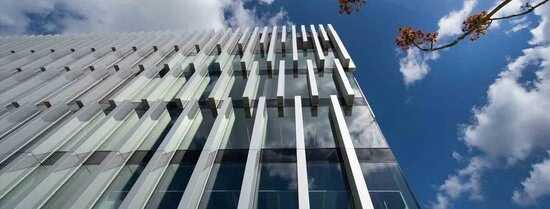In 2011 the university started reconstructing campus Woudestein in the context of Tomorrow's Campus. The goal of Tomorrow's Campus is to create a sustainable campus. A campus that provides a healthy and inclusive environment, with room for sports and relaxation and with plenty of meeting points and facilities. The plans include sustainable construction and renovation (as well as demolition and dismantling) of buildings, energy reduction and transition measures, and implementing a circular approach to building materials.

Campus under construction
In the coming years, we will continue to work to make our campus ready for the future. Our iconic Tinbergen Building is undergoing a large-scale sustainable renovation. But the campus grounds on the south side of the Erasmus Plaza will also be completely renewed, making room for lots of greenery, a ring road and two volleyball courts.
Portfolio roadmap energy transition
As we continue to develop the campus, we are taking several measures to save energy and reduce CO2 emissions, including:
- Sustainable heat recovery;
- Applying intelligent lighting;
- Application of LED lighting;
- Smart cooling of data centers;
- Applying solar panels;
- Connecting buildings to CHP systems;
- Installing green roofs (sedum roofs).
We aim to meet the CO2 reduction targets set out in the Rotterdam Climate Agreement. The Climate Agreement (28 June 2019) states that sectoral roadmaps should be drawn up for sectors within social real estate. These roadmaps analyse what real estate is, and how its CO2 emissions can be reduced to meet the climate targets. We aim to achieve net zero in our scope 1 and 2 emissions by 2035, and in our scope 3 by 2040, and the real estate and facilities energy roadmap builds the way towards these goals.
The purpose of the Portfolio Roadmap for the period from 2022 to 2050 is to provide a short- and long-term plan forour properties, indicating how adjustments will be made to each property in order to comply with the climate agreement.
Energy consumption
District heating energy consumption (generated with industrial residual heat) on campus Woudestein is 2023 has remained stable at 36,064 GJ, compared to 35,859 GJ in 2022. This is despite the two new buildings completed on campus in late 2022; Langeveld Building (BREEAM Outstanding) and Sports Building (energy neutral). Energy consumption is expected to decrease after the sustainable renovation of our largest building Tinbergen Building. This renovation started in 2024.
Electricity consumption shows a decrease, from 16,328,001 KWH in 2022 to 14,215,357 KWH in 2023, despite increased electricity demand due to the energy transition. This is the result of many measures we have implemented, among others:
Changing the opening hours of the offices on campus Woudestein to safe energy (for more information, click on the article blow)
Gradually changing lightbulbs with LED lighting, which uses 85-90% less electricity than halogen and incandescent lamps.
Reducing the temperature in our buildings in a structural manner.
Thermostat turned down at Erasmus University Rotterdam
The thermostat in all EUR buildings have been turned down to a temperature of 19 degrees Celsius. This decision was taken by the Executive Board of the university, after a national appeal from the government to save energy.
Changed opening hours offices Woudestein campus
Changed opening hours as of 1 April 2023, to reduce energy consumption.
Dutch wind energy
Erasmus University Rotterdam is making use of renewable energy. The university purchases "Guarantees of Origin' from Dutch wind energy. For 2021, EUR bought 17.500 megawatt hours of wind energy. That is equivalant to about eight wind turbines running for the EUR throughout the year, providing sustainable electricity.
Heat and cold storage (ATES)
EUR also applies heat and cold storage wherever possible, which is a method of storing energy in the form of heat or cold in the ground. This technique is used to sustainably heat and/or cool buildings. The following buildings are already connected to ATES:
- Erasmus Pavilion (incl. 1st floor of the Hatta building);
- University Library;
- Polak Building;
- Sanders Building;
- Erasmus Sport (new building);
- Langeveld Building;
- Theil Building.
In the future, Van der Goot Building, Tinbergen Building, Bayle Building and Mandeville Building will also be connected to the ATES system. Regular heat is provided by the district heating system (generated with industrial residual heat).


Solar energy
Finally, EUR also generates its own electricity through solar panels on the roofs of Erasmus Building, Theil Building, the University Library, the Erasmus Pavilion, Polak Building, Van der Goot Building and Mandeville Building. In 2023, the solar panels generated 358.613 KWh of electricity.
BREEAM-NL
BREEAM certification is currently the standard for determining the sustainability of buildings and the built environment. The new construction of the Langeveld Building was done according to the highest 'BREEAM New Construction and Renovation' guideline: 'Outstanding'. In addition, it is now being investigated whether the existing buildings can be certified according to BREEAM-in-USE. For the future demolition of buildings, it will be investigated whether this can also be done via BREEAM-NL Demolition and Dismantling.
